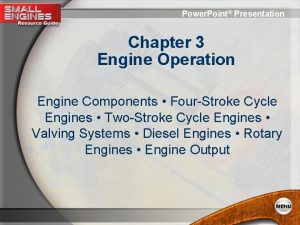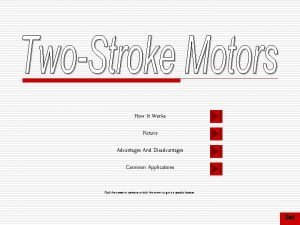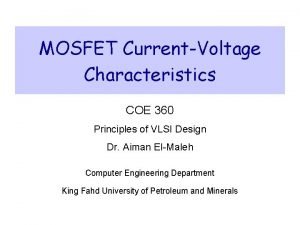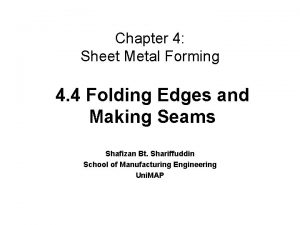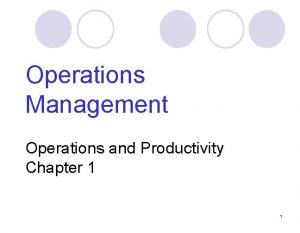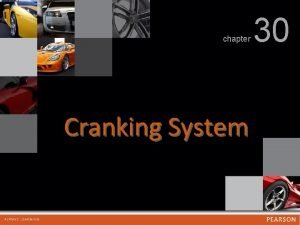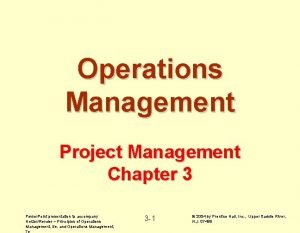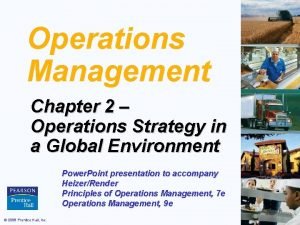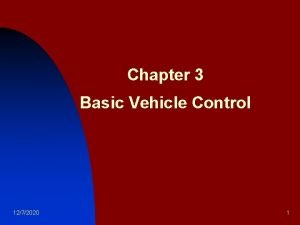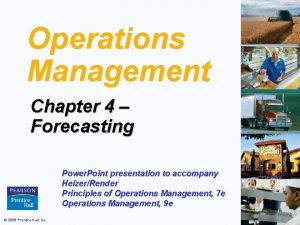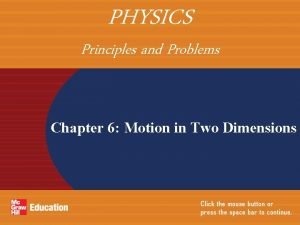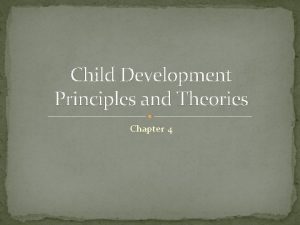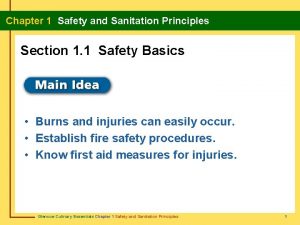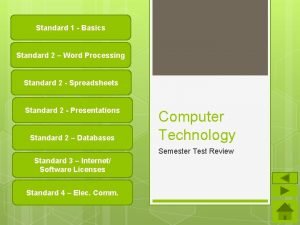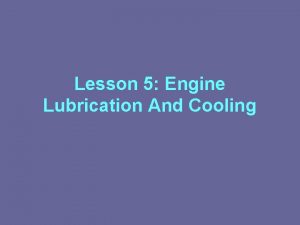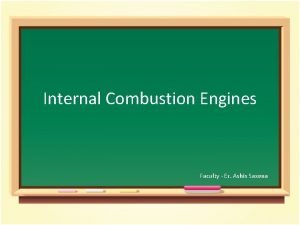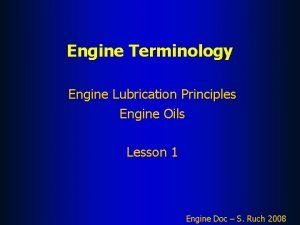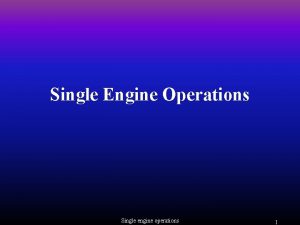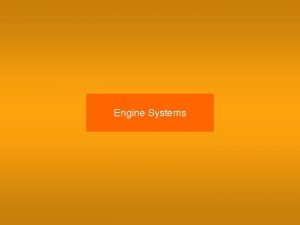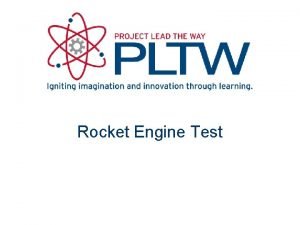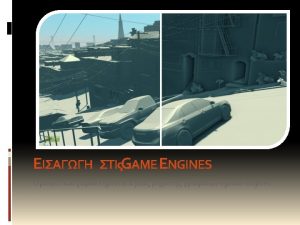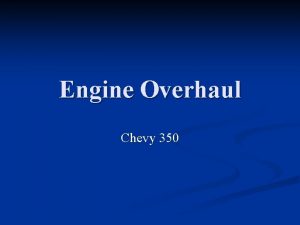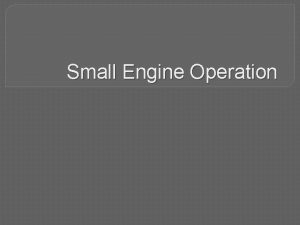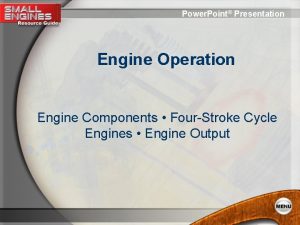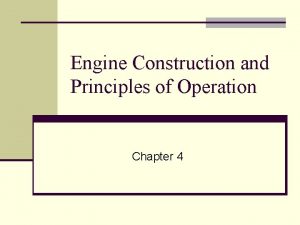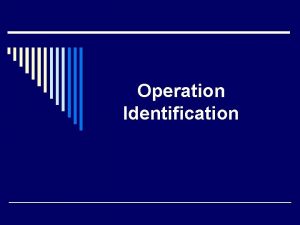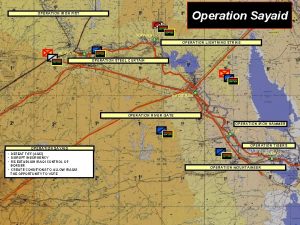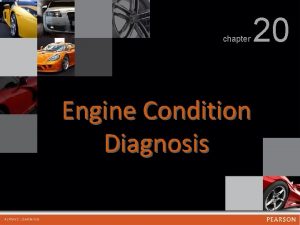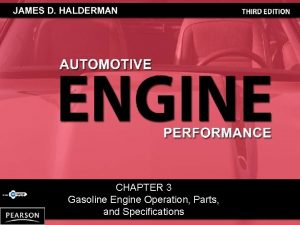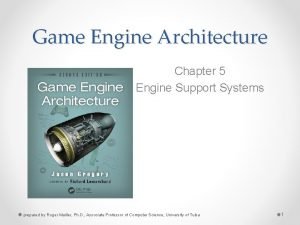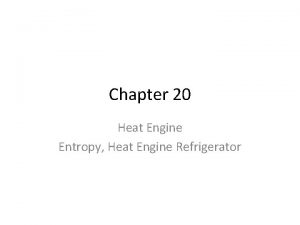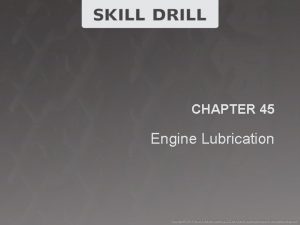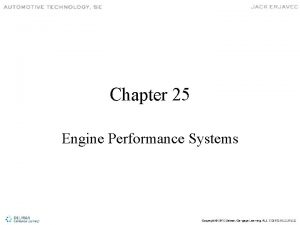CHAPTER 5 Principles of Engine Operation Two and



























- Slides: 27


CHAPTER 5 Principles of Engine Operation, Two- and Four -Stroke Engines

Learning Objectives • Explain simple engine operation. • Explain why gasoline is atomized in the small engine. • Describe four-stroke engine operation and explain the purpose of each stroke. • Explain the concept of valve timing. • Compare the lubrication system in a four-cycle engine to the system in a two-stroke engine. © Goodheart-Willcox Co. , Inc. Permission granted to reproduce for educational use only.

Learning Objectives • Describe two-stroke engine operation and explain the principles of two-cycle operation. • List the advantages and disadvantages of twostroke and four-stroke engines. © Goodheart-Willcox Co. , Inc. Permission granted to reproduce for educational use only.

Principles of Engine Operation • • Converts chemical energy into mechanical energy Gasoline engine is an internal combustion engine Gasoline must ignite easily and burn quickly Energy produced by burning gasoline must be controlled © Goodheart-Willcox Co. , Inc. Permission granted to reproduce for educational use only.

Gasoline Must Be Atomized • The more surface area exposed to air, the more vapor will be given off • More vapor leads to faster burning • Gasoline must be atomized • Atomization – Increased burning area – Explosive release of heat energy © Goodheart-Willcox Co. , Inc. Permission granted to reproduce for educational use only.

Elementary Engine © Goodheart-Willcox Co. , Inc. Permission granted to reproduce for educational use only.

Two- and Four-Stroke Engines • Engines identified by number of piston strokes required to complete one operating cycle • Each stroke is either toward the rotating crankshaft or away from it – Bottom dead center – Top dead center • Strokes identified by job they perform © Goodheart-Willcox Co. , Inc. Permission granted to reproduce for educational use only.

Four-Stroke Engine • Four strokes needed to complete operating cycle – Intake stroke – Compression stroke – Power stroke – Exhaust stroke • Two strokes occur during each crankshaft revolution • Two crankshaft revolutions complete one operating cycle © Goodheart-Willcox Co. , Inc. Permission granted to reproduce for educational use only.

Four-Stroke Engine © Goodheart-Willcox Co. , Inc. Permission granted to reproduce for educational use only.

Intake Stroke • Piston travels downward • Volume of space above piston increases – Creates partial vacuum • Intake valve open and exhaust valve closed © Goodheart-Willcox Co. , Inc. Permission granted to reproduce for educational use only.

Intake Stroke • Atmospheric pressure forces air through carburetor, through intake valve port, and into cylinder • Intake valve must open and close at the correct time – Incoming air-fuel mixture cools valve during engine operation © Goodheart-Willcox Co. , Inc. Permission granted to reproduce for educational use only.

Compression Stroke • Piston moves upward • Both valves closed • Mixture is compressed – Force of combustion is increased © Goodheart-Willcox Co. , Inc. Permission granted to reproduce for educational use only.

Power Stroke • Both valves closed • Air-fuel mixture ignited • Burning action forces piston downward © Goodheart-Willcox Co. , Inc. Permission granted to reproduce for educational use only.

Exhaust Stroke • Intake valve closed and exhaust valve open • Rising piston pushes exhaust gases from engine © Goodheart-Willcox Co. , Inc. Permission granted to reproduce for educational use only.

Exhaust Stroke • Exhaust valve – Allow a streamlined flow of exhaust gases – Heat must be controlled © Goodheart-Willcox Co. , Inc. Permission granted to reproduce for educational use only.

Four-Stroke Engines • Valve Timing – Measured in degrees of crankshaft rotation – Varies with different engines – Valve overlap • Lubrication – Provided by oil in the crankcase • Splash and pump systems – Oil must be drained and replaced periodically © Goodheart-Willcox Co. , Inc. Permission granted to reproduce for educational use only.

Two-Stroke Engine • Two strokes occur during each revolution of crankshaft • Advantages over four-stroke engine – Simpler in design – Smaller – Lighter – Adequate lubrication at extreme angles © Goodheart-Willcox Co. , Inc. Permission granted to reproduce for educational use only.

Two-Stroke Engine (Kohler Co. ) © Goodheart-Willcox Co. , Inc. Permission granted to reproduce for educational use only.

Two-Stroke Engine Operation (Rupp Industries, Inc. ) © Goodheart-Willcox Co. , Inc. Permission granted to reproduce for educational use only.

Intake into Crankcase • Piston moving upward • Crankcase pressure drops • Intake port exposed • Intake air through carburetor pulls fuel and oil into crankcase © Goodheart-Willcox Co. , Inc. Permission granted to reproduce for educational use only.

Ignition-Power • Piston moving upward • Compresses air-fuel charge • Spark ignites air-fuel mixture • Piston driven downward – Creates crankshaft motion © Goodheart-Willcox Co. , Inc. Permission granted to reproduce for educational use only.

Exhaust • Piston moving downward • Exhaust port exposed • Exhaust gases expelled • Complete exhausting occurs when transfer ports are opened – New charge rushes in © Goodheart-Willcox Co. , Inc. Permission granted to reproduce for educational use only.

Fuel Transfer • Piston moving downward • Air-fuel charge in crankcase compressed • Transfer port opened – Compressed charge rushes through port © Goodheart-Willcox Co. , Inc. Permission granted to reproduce for educational use only.

Scavenge Loss • Occurs when a significant portion of the air-fuel charge flows out through the open exhaust port • Scavenge loss results in increased hydrocarbon emissions and reduced fuel economy © Goodheart-Willcox Co. , Inc. Permission granted to reproduce for educational use only.

Stratified Scavenge Engine • Two-cycle engine that eliminates scavenge loss – Extra intake port and a specially shaped piston introduce fresh air into the transfer port ahead of the air fuel charge – Fresh air flows into the cylinder before the air-fuel charge, pushing the spent exhaust gases from the cylinder and preventing the air-fuel charge from escaping through the exhaust port © Goodheart-Willcox Co. , Inc. Permission granted to reproduce for educational use only.

Four-Stroke Engine vs. Two-Stroke Engine © Goodheart-Willcox Co. , Inc. Permission granted to reproduce for educational use only.
 Chapter 5 two-cycle and four-cycle engines answers
Chapter 5 two-cycle and four-cycle engines answers Engine operation chapter 3 test 1 answer key
Engine operation chapter 3 test 1 answer key Internal combustion engine vs external combustion engine
Internal combustion engine vs external combustion engine Advantages and disadvantages of two stroke engine
Advantages and disadvantages of two stroke engine Vlsi
Vlsi Types of sheet metal seams
Types of sheet metal seams Linux operation and administration chapter 8
Linux operation and administration chapter 8 Operations and productivity chapter 1
Operations and productivity chapter 1 Chapter 3 shielded metal arc equipment setup and operation
Chapter 3 shielded metal arc equipment setup and operation Chapter 30 engine starting systems
Chapter 30 engine starting systems Operations management chapter 3 solutions
Operations management chapter 3 solutions Chapter 2 operations management
Chapter 2 operations management Basic vehicle control
Basic vehicle control Introduction of operation management
Introduction of operation management Process selection operations management
Process selection operations management Operation management chapter 5
Operation management chapter 5 Competitive operations strategy
Competitive operations strategy Associative forecasting example
Associative forecasting example 12 principles of distribution channel management
12 principles of distribution channel management Chapter 6 study guide motion in two dimensions
Chapter 6 study guide motion in two dimensions Child development principles
Child development principles Chapter 4 assessment physics
Chapter 4 assessment physics Chapter 2 representing motion
Chapter 2 representing motion Chapter 1 safety and sanitation principles
Chapter 1 safety and sanitation principles Difference between web browser and search engine
Difference between web browser and search engine Relie responsible lending and insights engine
Relie responsible lending and insights engine Lubrication of couling systems
Lubrication of couling systems Si and ci engine
Si and ci engine

